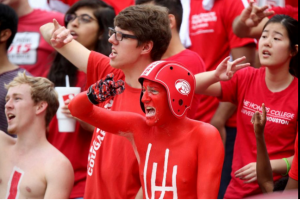Cougars’ nearly perfect season draws attention to rising university
Benjamin Wermundfor the Houston Chronicle, November 27, 2015
Friday’s football game between the University of Houston and Navy was sold out long before kickoff – to the apparent disbelief even of the university’s biggest cheerleader.
“Please don’t call me for UH-Navy tickets,” President Renu Khator tweeted 10 days before the game. “I don’t have any. The game is really sold out!”
The Cougars’ nearly perfect season has drawn even more attention to the city’s rising research university. Those who haven’t followed UH closely in recent years may be surprised about the changing culture on the southeast Houston campus, which is looking more like a traditional residential college than ever before.
The university’s rising stature in classrooms and labs, along with its athletes’ performance on the football field, has helped to make students more engaged in the life of a campus once dominated by part-time scholars commuting to and from class. Not only are more students rallying at tailgates at the university’s new football stadium, but more are staying on campus, in student housing new and old. Participation in student organizations has increased sharply in recent years.
The university has invested heavily in creating a community. It has spent millions to build new dorms and to upgrade a student center with restaurants, study spaces and a neon-lighted bowling alley. That’s because research shows the more engaged students are, the more likely they are to stick around and graduate – and the more likely they are to give back once they’ve earned their degrees.
Unbeaten Cougars hope success puts them on the national map again
“Those physical changes brought a culture change,” said Cedric Bandoh, who graduated from UH in 2014 after serving as student body president and is now a member of the UH alumni board. “I’ve seen a sea change just in my time at the university.”
In some cases, UH’s efforts to engage more students have led to questions from inside and outside the university.
Unmistakable change
When administrators proposed requiring freshmen to live on campus, state Sen. John Whitmire, an alumnus, voiced outrage that UH may be forsaking the working class it had long served. He expressed his concerns in a series of text messages to Khator, who swiftly killed the plan.
Some faculty, meanwhile, have voiced consternation over the university’s focus on athletics, at times at the literal expense of academics.
UH’s athletics programs rely heavily on subsidies from other areas of the university. Still, the change is unmistakable.
Roughly half of freshmen now live on campus, and UH’s residence halls are nearly all full. The school has 476 registered student organizations – an 8.5 percent increase from last year. The university’s Metropolitan Volunteer Program, which seeks to create service opportunities for students, saw a 114 percent increase in participation from last year. And participation in some student events has grown, as well – the annual Frontier Fiesta drew 31 percent more attendants this year, driven in part by bigger acts. About 8,000 students came out to see rapper Schoolboy Q headline the March festival.
To university officials, the increased student engagement is almost as much a victory as luring nationally renowned faculty and federally funded research facilities. If UH wants to become a top-tier university, it will have to lift its lagging graduation rates – and getting students involved is a proven way to do that.
“We know that it’s not just the classroom that makes a difference,” said Tina Powellson, director for the Center for Student Involvement. “Their involvement on campus is, in my opinion, the biggest part of keeping them on campus and toward graduation. Students that get involved have higher GPAs and are more likely to get jobs.”
While UH has invested in drumming up engagement – spending millions renovating the student center and building new dorms and, of course, the new football stadium – students have bought in, covering a lot of the cost of the new construction by paying higher fees.
‘Fear of missing out’
Students agreed to cover 95 percent of the $80-million face lift to the old University Center, now renamed the University of Houston Student Center. In 2008, 77 percent of the 4,161 students who turned out at an election supported raising fees to renovate the facility. The fee increase also was supported by student government and approved by the Board of Regents. The fee dedicated to the center has jumped more than 285 percent since then to $135, where it will remain until 2037, according to university estimates.
Students also agreed to pay $45 more in fees every semester to help pay for the football stadium. The disputes between student leaders and administrators over the use of those funds haven’t dissuaded students from showing up to the $120 million stadium on game days. Red-shirted students now throw footballs, grill burgers and swill beer at lively tailgates before filling the student section for home games.
“We’re winning a lot more, but I think a lot more students are going to these games,” said Charlotte Christian, a political science major set to graduate this spring. “There’s a fear of missing out because so many exciting things are happening at the games, but it’s also a tradition that people can identify and count on going to. It’s becoming more and more part of the core campus culture.”
